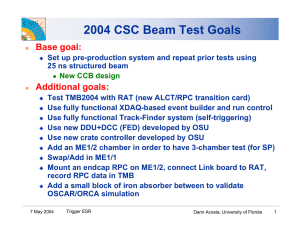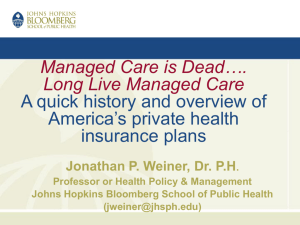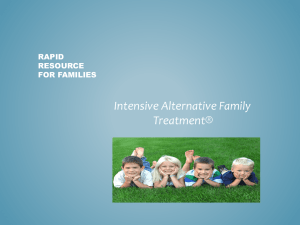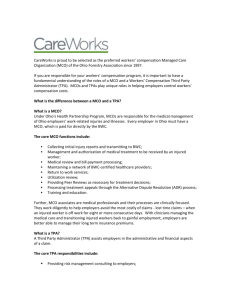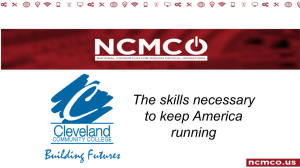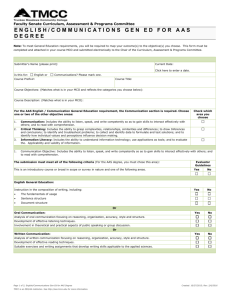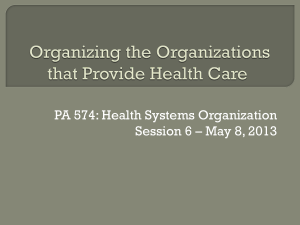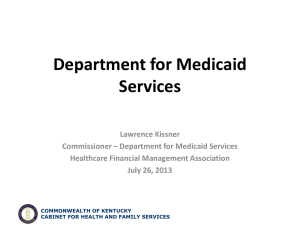PeterAshenden
advertisement
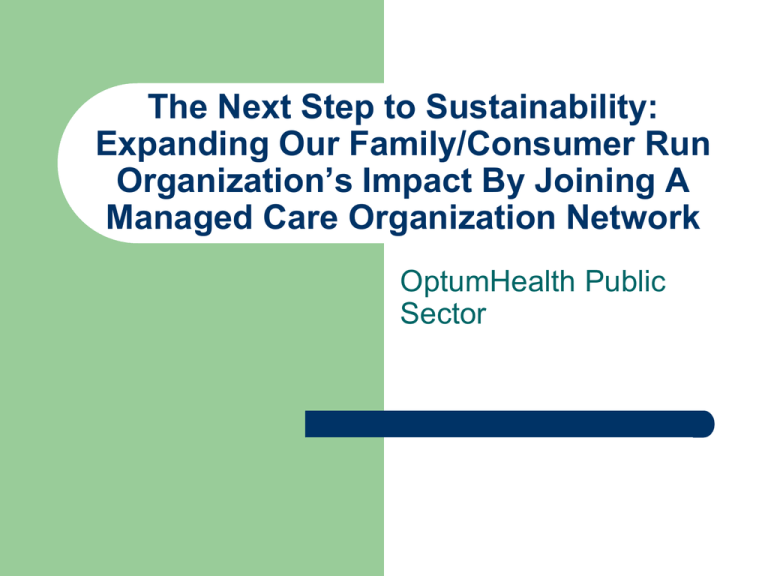
The Next Step to Sustainability: Expanding Our Family/Consumer Run Organization’s Impact By Joining A Managed Care Organization Network OptumHealth Public Sector Welcome: Peter Ashenden, Director of Consumer Affairs, OptumHealth Peter.Ashenden@optumhealth.com Pamela Fox, Manager of Peer and Community Services for Optum Health Tennessee pamela_b_fox@uhc.com Objectives Understand how managed care works Be able to identify what programs you offer that might be funded through a managed care contract Clarify the pros and cons of working within a managed care network Know what steps to take to move forward to seek a contract Do we want to explore becoming a part of an MCO Network? Manual Chapter 1 YES NO Does our organization agree with the concept of increasing the use of community based services and therefore decreasing unnecessary hospitalization? Is our organization seeking ways to help break the cycle of the illnesses and move to wellness? Do we believe we will learn something that will help us advocate on behalf of those we serve by being a part of a managed care network? Can we commit to remain advocates despite being a part of an MCO network? Can we see ways our organization can help an MCO learn to be more recovery and resiliency oriented by being a part of a network? Managed Care 101: Manual Chapter 2 What is Managed Care? Managed care is the integration of providers and payors into an organized system designed to offer quality, cost effective care, while assuring consumer satisfaction with services. What is Managed Care (Continued) In addition to cost savings, managed care: Helps make healthcare more affordable; Provides shared electronic records; Pre-set clinical guidelines, which improve consumer/family health outcomes; and Introduced accountability for providers and the managed care organization. How Does Managed Care Operate? Managed care organizations collaborate with consumers/families, providers, and payors to provide a system of care that supports inclusion and help for consumers. Why is Care Managed? Increased cost of health care, and the need to find middle ground between paying for everything and paying for nothing; Limits are put in place based on what is reasonable based on research, and what the employer/state/government determines they will authorize; and Managed care also helps to monitor waste. What is the Cycle within Managed Care? The managed care organization and the employer group agree to a contract, which outlines benefits and limitations of services. MCO seeks providers for a network based on the needs outlined in the employer contract Providers agree to a contract that sets the fees Consumers/families are referred to providers within the network Some services require authorization before access, based on contract What is the Cycle of Managed Care? (Continued) Consumers who are heavy users of services will be assigned a case manager to help them access enriched services Providers submit payment for the services using the federal codes and modifiers agreed to for the services MCO reviews submission to ensure it is within the contracted services for each employer contract What is the Cycle of Managed Care? (Continued) Checks are cut Quality and compliance audits are done Key Take Away Points The MCO process works as follows: Providers are credentialed Agreements are signed Services are provided Claims are submitted and paid, based on negotiated rates Quality monitoring on-going Consumer and provider satisfaction tracked and trended What You Have to Offer: Manual Chapter 3 MCO “Sweet Spots” What can decrease hospitalization rates? What can stop the revolving door for consumers who are in and out of hospitals and ERs? What can increase HEDIS Scores? – – 7 day post hospitalization follow up medication refill rates What can increase adherence? What can sustain wellness? Managed Care “Sweet Spot” What can engage and empower consumers in their own self care? What can promote natural support and decrease isolation? What can increase wellness, especially with chronic co morbid conditions? What does your Consumer operated program have that an MCO would want? Programs that reduce hospitalization: Programs that increase HEDIS numbers: Programs that increase adherence: Programs that enhance wellness – especially among chronic conditions: Any research? Capacity limitations? Any quality indicators? Selection And Contracting From The MCO Perspective: Manual chapter 5 Factors that Compel an MCO to Recruit Peer or Family Run Organizations Client/customer expectation – RFP requirement Managed Care Company philosophy – – – – – Educate and heighten staff awareness and sensitivity Integrate consumer/family voice into planning, evaluation and delivery of service Fill a gap in service delivery and service delivery coordination Raise provider awareness and perspective of consumers/families as part of the delivery system Offer innovate and creative alternatives to enrich traditional services What do MCO’s need from network participants High quality services that are also compliant with state and federal regulatory requirements Services that achieve positive, measureable results Support health care affordability principles and result in a cost effective approach to services Contracting Process Steps Confirm network needs – Reach out directly to MCO to discuss unmet needs (e.g., results of HEDIS scores) Complete application and paperwork necessary to participate – Learn relevant credentialing criteria Participate in contract negotiation process Maintain copies of all paperwork including welcome letter and signed/executed agreement Participate in provider trainings/forums – Obtain copies of provider handbooks (usually posted on website) Determine any appeal processes if not offered participation Get Set: Pam What I Have To Have In Place To Get Started Manual chapters 6 & 9 Get Set: What I need to have in place There are many things that need to happen BEFORE the process of contracting with a MCC begins Develop a clear and detailed description of the services your agency is willing to provide – – – City & county to be served Your organizations experience And any outcome data available List the type of license your organization has Provide a detail description of the service – Days/hours of operation – Age group to be served - Staff to consumer ratio Get Set: What I need to have in place, continued Describe the anticipated length of stay for individuals utilizing this service and the number of individuals you plan to serve within a year Identify where you propose referrals to come from and your marketing strategy to inform those sources of the service once established Once you have the description in place with pertinent information you can contact the managed care company to inform them of your interest. As you begin the dialogue with any managed care company (MCC) you should begin working on other tasks such as your EIN, NPI number, Medicaid number, etc. Get Set: What I need to have in place National Provider ID# (NPI number) Medicaid & Medicare number (Need to contact your Medicaid / Medicare contractor servicing your state) Appropriate license for the service you plan to provide Insurance to cover professional liability (depending on the service provided the amount could be $1M – $5M) Be prepared to be audited at anytime by Managed Care, Licensure, Fire Marshall and Medicaid These are major steps! Administrative Details of Success: Pam Manual chapter 7 & 8 Administrative Details Clarify payment terms as you develop a contract - fee for service vs capitation rate - electronic billing or invoice billing Are there service limits (minimum or maximum)? Is pre authorization required? Typically, yes if; – – – The service is costly The service is one closely monitored (usually for reporting) To ensure medical necessity criteria is met Coordination of benefits (issues to address) – Sometimes individuals have two insurance policies, Medicare & Medicaid, depending on how your services are contracted will depend on how the service is billed and paid Other tools to help you succeed Strong negotiating skills Do you need start-up funds? Should you begin with a “pilot” program before a completed fee for service contract? Have three – four months of reserve money (six is ideal) A good computer system with strong security is necessary Other tools to help you succeed Program Staff: Strong leadership Flexible and patient Handle Change Administrative staff (HR, Billing, Finance) Start up slow Add additional managed Care Companies Personal Strategy Plan: next steps worksheet questions Questions/Comments Evaluation Thank you
